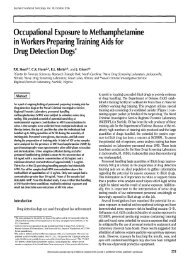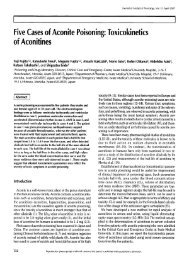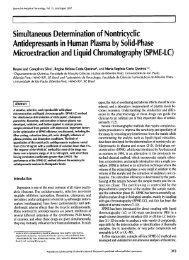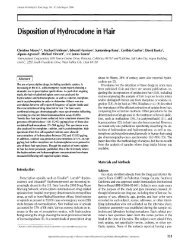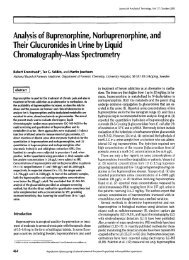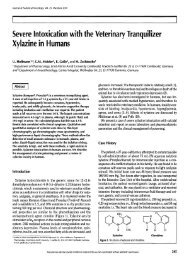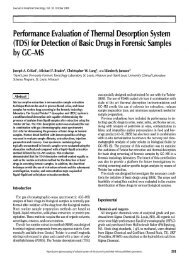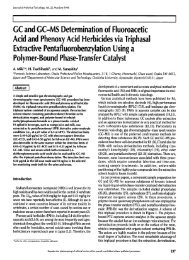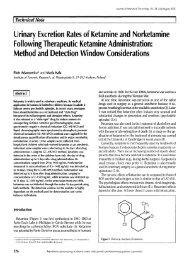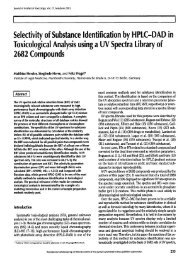A Fatality Related to the Veterinary Anesthetic Telazol - Journal of ...
A Fatality Related to the Veterinary Anesthetic Telazol - Journal of ...
A Fatality Related to the Veterinary Anesthetic Telazol - Journal of ...
Create successful ePaper yourself
Turn your PDF publications into a flip-book with our unique Google optimized e-Paper software.
[Case Report<br />
<strong>Journal</strong> <strong>of</strong> Analytical Toxicology, Vol. 23, Oc<strong>to</strong>ber 1999<br />
A <strong>Fatality</strong> <strong>Related</strong> <strong>to</strong> <strong>the</strong> <strong>Veterinary</strong> Anes<strong>the</strong>tic <strong>Telazol</strong><br />
Chris<strong>to</strong>pher J. Cording*, Robert Detuca, Thomas Camporese, and Elizabeth Spratt<br />
Westchester County Department <strong>of</strong> Labs and Research, 2 Dana Road, Valhalla, New York, 10595<br />
[Abstract }<br />
A 45-year-old male veterinarian was found dead in bed. Police<br />
investigation showed no evidence <strong>of</strong> trauma or o<strong>the</strong>r suspicious<br />
circumstances. Au<strong>to</strong>psy was unremarkable except for cardiomegaly<br />
and hepa<strong>to</strong>splenomegaly. Toxicological analysis revealed <strong>the</strong> presence<br />
<strong>of</strong> <strong>Telazol</strong> and ketamine. <strong>Telazol</strong> is a veterinary anes<strong>the</strong>tic agent that<br />
is composed <strong>of</strong> equal parts <strong>of</strong> tiletamine and zolazepam. Tiletamine<br />
is a disassociative anes<strong>the</strong>tic similar <strong>to</strong> ketamine and phencyclidine,<br />
and zolazepam is a diazepine derivative tranquilizer used <strong>to</strong> minimize<br />
<strong>the</strong> muscle hyper<strong>to</strong>nicity and seizures associated with tiletamine.<br />
Quantitation <strong>of</strong> tiletamine and zolazepam was performed using gas<br />
chroma<strong>to</strong>graphy-mass spectrometry in <strong>the</strong> selected ion moni<strong>to</strong>ring<br />
mode following a solid-phase extraction. Postmortem blood, urine,<br />
and liver concentrations <strong>of</strong> tiletamine were 295 ng/mL, 682 ng/mL,<br />
and 196 ng/g, respectively, whereas postmortem concentrations <strong>of</strong><br />
zolazepam for <strong>the</strong> same tissues were 1.71 pg/mL, 1.33 pg/mL, and<br />
15.5 pg/g, respectively. Blood and urine ketamine levels were 37<br />
ng/ml, and 381 ng/mL, respectively. The cause <strong>of</strong> death was<br />
ruled an acute mixed drug in<strong>to</strong>xication <strong>of</strong> tilelamine, zolazepam,<br />
and ketamine with <strong>the</strong> manner <strong>of</strong> death ruled as unclassified.<br />
Introduction<br />
<strong>Telazol</strong> is a non-narcotic, nonbarbiturate, injectable veterinary<br />
anes<strong>the</strong>tic agent that is equal parts by weight <strong>of</strong> tiletamine and<br />
zolazepam. Tiletamine (2-[ethylamino]-2-[2-thienyl]-cyclohex-<br />
anone hydrochloride) is an arylcyclohexylamine structurally<br />
related <strong>to</strong> phencyclidine and ketamine. Like ketamine and phen-<br />
cyclidine, it produces dissociative anes<strong>the</strong>sia primarily by selec-<br />
tively interrupting <strong>the</strong> association pathways <strong>to</strong> <strong>the</strong> brain before<br />
producing a somes<strong>the</strong>tic sensory blockade (1). Tiletamine pro-<br />
duces a spectrum <strong>of</strong> central nervous system (CNS) effects<br />
ranging from excitement and ataxia at low doses <strong>to</strong> catalepsy and<br />
anes<strong>the</strong>sia at higher doses. These CNS effects are highly species<br />
specific, but catalepsy prevails in all species at moderate doses<br />
(2). The anes<strong>the</strong>sia produced by tiletamine resembles a catalep-<br />
<strong>to</strong>id state in which <strong>the</strong> eyes remain open with a slow nystagmus<br />
gaze (3).<br />
Zolazepam (4-[o-fluorophenyl]-6,8 dihydro-l,3,8-trimethyl<br />
pyrazolo [3,4-e][1,4] diazepin-7[1H]-l-hydrochloride)is a non-<br />
phenothiazine diazepine tranquilizer used <strong>to</strong> reduce <strong>the</strong> muscle<br />
hyper<strong>to</strong>nicity and seizures associated with tiletamine (1).<br />
<strong>Telazol</strong> produces anes<strong>the</strong>sia within 5-]2 rain <strong>of</strong> administration<br />
* Author <strong>to</strong> whom correspondence should be addressed.<br />
and optimum muscle relaxation within 20-25 min (1). <strong>Telazol</strong> is<br />
approved for use in cats and dogs, although it has also been<br />
proven <strong>to</strong> be effective for restraint and induction <strong>of</strong> anes<strong>the</strong>sia in<br />
a wide variety <strong>of</strong> animals ranging in size from rats <strong>to</strong> polar bears<br />
(4). <strong>Telazol</strong> is supplied as 500 mg <strong>of</strong> active drug. With <strong>the</strong> addi-<br />
tion <strong>of</strong> 5 mL <strong>of</strong> supplied diluent, it is equivalent <strong>to</strong> a solution <strong>of</strong><br />
50 mg/mL <strong>of</strong> base for each compound.<br />
Case His<strong>to</strong>ry<br />
A 45-year-old male veterinarian, (104 kg, 1.8 m) was found in an<br />
unresponsive state by a home-care worker who was tending <strong>to</strong><br />
<strong>the</strong> deceased's 79-year-old mo<strong>the</strong>r. The deceased was found<br />
kneeling by his mo<strong>the</strong>r's bed with his <strong>to</strong>rso draped over his<br />
mo<strong>the</strong>r's legs. The home-care worker called <strong>the</strong> deceased's sister<br />
who arrived on <strong>the</strong> scene and called <strong>the</strong> police. Police arrived and<br />
determined that <strong>the</strong>re was no trauma or o<strong>the</strong>r suspicious cir-<br />
cumstances. Found at <strong>the</strong> scene were two syringes, two empty<br />
vials <strong>of</strong> <strong>Telazol</strong>, an empty vial <strong>of</strong> ketamine, and a bottle con-<br />
taining 49 Centrine pills. Centrine is <strong>the</strong> trade name for<br />
aminopentamide, which is an anticholinergic (5). The deceased<br />
had a his<strong>to</strong>ry <strong>of</strong> ketamine use.<br />
The mo<strong>the</strong>r was transported <strong>to</strong> a hospital where she sub-<br />
sequently died. She suffered from Alzheimer's disease and was<br />
unable <strong>to</strong> recount any details <strong>of</strong> her son's death. Fears <strong>of</strong> a<br />
murder-suicide were dispelled when <strong>the</strong> mo<strong>the</strong>r's <strong>to</strong>xicology<br />
report proved <strong>to</strong> be negative. Her au<strong>to</strong>psy showed that death was<br />
due <strong>to</strong> natural causes.<br />
An au<strong>to</strong>psy was conducted on <strong>the</strong> deceased on <strong>the</strong> day <strong>of</strong> death.<br />
The findings were unremarkable except for cardiomegaly and<br />
hepa<strong>to</strong>splenomegaly. The body was slightly decomposed. There<br />
were no injection sites noted. A general <strong>to</strong>xicological screen for<br />
drugs and ethanol was performed on blood and urine specimens<br />
collected at au<strong>to</strong>psy using immunoassay, headspace gas chro-<br />
ma<strong>to</strong>graphy, and high-performance liquid chroma<strong>to</strong>graphy-<br />
mass spectrometry (HPLC-MS).<br />
Experimental<br />
Materials<br />
Tiletamine and zolazepam were supplied individually by Wyeth-<br />
Ayerst Labs (St. Davids, PA) in association with Fort Dodge<br />
Animal Health (Fort Dodge, IA). Phencyclidine (PCP)-ds was<br />
552 Reproduction (pho<strong>to</strong>copying) <strong>of</strong> edi<strong>to</strong>rial content <strong>of</strong> this journal is prohibited without publisher's permission.
<strong>Journal</strong> <strong>of</strong> Analytical Toxicology, Vol. 23, Oc<strong>to</strong>ber 1999<br />
purchased from Radian (Austin, TX) as a methanolic solution at<br />
a concentration <strong>of</strong> 100 lJg/mL. SKF-525A was purchased from<br />
Sigma Chemical Co. (St. Louis, MO), and 5-ethyl-5-p-<strong>to</strong>lyl-<br />
barbituric acid was purchased from Aldrich Chemical Co.<br />
(Milwaukee, WI). The chemicals used in <strong>the</strong> extraction were<br />
analytical grade. The solid-phase extraction columns employed<br />
were United Chemical Technologies (Bris<strong>to</strong>l, PA) Clean Screen<br />
ZSDAU020 extraction columns.<br />
Methanolic s<strong>to</strong>ck solutions were made for <strong>the</strong> tiletamine and<br />
zolazepam at a concentration <strong>of</strong> 1 mg/mL. This s<strong>to</strong>ck was fur-<br />
<strong>the</strong>r diluted <strong>to</strong> a combined working standard <strong>of</strong> I IJg/mL. This<br />
working standard was used <strong>to</strong> prepare calibration standards in<br />
blood <strong>of</strong> 12, 25, 50, 100, and 300 ng/mL for <strong>the</strong> tiletamine and<br />
zolazepam. An independent blood-based control was also pre-<br />
pared. A PCP-d5 s<strong>to</strong>ck solution <strong>of</strong> 3.33 IJg/mL was prepared as an<br />
internal standard from <strong>the</strong> 100-1Jg/mL Radian standard.<br />
Instrumentation<br />
A Hewlett-Packard (HP) HPLC-MS system was used for <strong>the</strong><br />
initial screening. It consists <strong>of</strong> an HP 1050 series HPLC pump,<br />
au<strong>to</strong>injec<strong>to</strong>r, and UV detec<strong>to</strong>r with an HP 59980B particle beam<br />
interfaced with an HP 5989B MS. It used an Altima (Deerfield,<br />
IL) C18, 5-1Jm Direct Connect Guard cartridge (#88058)<br />
Abundance #145: Tiletamine rrt=0.159 (*)<br />
116<br />
8000<br />
6000<br />
4000 II0123<br />
2000 51 69 83 ,Jl,,..,,fl ..,,,~38,i,,,,<br />
0 LH,J.., , .l,l.h. hd ,.<br />
9 /z--> '"6'o"'~'o'"L66"L~6"L~6"L~<br />
195<br />
Figure 1. Structure and particle beam LC-MS El mass spectrum <strong>of</strong> tiletamine.<br />
Abundance<br />
m/z--><br />
8000<br />
6000<br />
4000<br />
2000.<br />
0<br />
attached <strong>to</strong> a 5-1Jm Altima C18 (20 mm x 2.1 mm) column. The<br />
HPLC was run with a gradient that began with 100% <strong>of</strong> a mobile<br />
phase A (deionized water/ace<strong>to</strong>nitrile, 90:10, 0.05% trifluo-<br />
roacetic acid) for 5 min and ended with 100% <strong>of</strong> a mobile phase<br />
B (deionized water/ace<strong>to</strong>nitrile, 20:80, 0.05% trifluoroacetic<br />
acid) after 55 min at a flow <strong>of</strong> 0.25 mL/min with a column tem-<br />
perature <strong>of</strong> 40~ Total run time was 70 min which allows for re-<br />
equilibration <strong>of</strong> <strong>the</strong> column. The UV detec<strong>to</strong>r scanned between<br />
205 and 290 nm. The MS was set in <strong>the</strong> electron impact (EI)<br />
mode <strong>to</strong> scan for ions in <strong>the</strong> range <strong>of</strong> 50-500 ainu. The struc-<br />
tures and LC-MS EI spectra for tiletamine and zolazepam are<br />
shown in Figures I and 2, respectively.<br />
A Hewlett-Packard (Palo Al<strong>to</strong>, CA) model 5890 series II+ gas<br />
chroma<strong>to</strong>graph (GC) with a 5972 series mass selective detec<strong>to</strong>r<br />
was employed for <strong>the</strong> quantitation. The column was an HP-<br />
Ultra-1 crosslinked methyl siloxane column (12 m x 0.2-ram<br />
i.d., 0.3-1~m film thickness). The injec<strong>to</strong>r temperature was set <strong>to</strong><br />
250~ and <strong>the</strong> detec<strong>to</strong>r was set <strong>to</strong> 280~ The initial oven tem-<br />
perature was 135~ The temperature was <strong>the</strong>n ramped <strong>to</strong> 220~<br />
at a rate <strong>of</strong> 25~ After being held at 220~ for 1 min, <strong>the</strong><br />
temperature was ramped <strong>to</strong> 320~ at a rate <strong>of</strong> 30~ for a<br />
<strong>to</strong>tal run time <strong>of</strong> 8.73 min. The MS was run in <strong>the</strong> EI mode with<br />
selected ion moni<strong>to</strong>ring using a target ion and two qualifying<br />
iL I1206 223 240 268 284 319<br />
#146: Zolazepam rrt-0.238 (*)<br />
2~:72 5<br />
69<br />
145<br />
51 i09 134k 180 199 230<br />
i'; .... 160 1go '' '260 .... 2g, ~360'<br />
Figure 2. Structure and particle beam LC-MS El mass spectrum <strong>of</strong> zolazepam.<br />
32~ 3s~68 394 42o<br />
'' '3~0 .... 460'''<br />
S-<br />
~<br />
NH~Hs<br />
OHc I<br />
~H3 CH3<br />
CH2 ,____~N<br />
~ F HCl<br />
553
ions for each compound. The target ion for tiletamine was 166<br />
with qualifiers <strong>of</strong> 195 and 110; <strong>the</strong> target ion for zolazepam was<br />
285 with qualifiers <strong>of</strong> 267 and 257; and <strong>the</strong> target ion for PCP-ds<br />
was 205 with 247 and 248 as its qualifying ions. Retention times<br />
for tiletamine, PCP-ds, and zolazepam were 3.74, 4.84, and 6.87<br />
min, respectively (Figure 3).<br />
Procedure<br />
The LC-MS screening procedure in which <strong>the</strong> compounds<br />
were detected was a liquid-liquid extraction at both neutral and<br />
alkaline pHs. Buffer (1 mL, pH 7) was added <strong>to</strong> a 5-mL sample <strong>of</strong><br />
blood or urine. Both I lag <strong>of</strong> SKF-525 A and 6 lag <strong>of</strong> 5-ethyl-5-p-<br />
<strong>to</strong>lybarbituric acid were added as internal standards. After <strong>the</strong><br />
addition <strong>of</strong> 7 mL <strong>of</strong> hexane/<strong>to</strong>luene/isoamyl alcohol (90:5:5), <strong>the</strong><br />
samples were vortex mixed and centrifuged. The organic layer<br />
was removed <strong>to</strong> a clean test tube. Buffer (1 mL, pH 9.5) was<br />
added <strong>to</strong> <strong>the</strong> remaining aqueous layer. The alkaline fraction was<br />
<strong>the</strong>n extracted using 6 mL <strong>of</strong> hexane/isoamyl alcohol (99:1). The<br />
two extracts were combined and dried down under nitrogen. The<br />
samples were reconstituted with 250 laL <strong>of</strong> deionized water/ace-<br />
<strong>to</strong>nitrile (55:45), 0.05% trifluoroacetic acid. The samples were<br />
<strong>the</strong>n dried down <strong>to</strong> approximately half <strong>the</strong>ir volume <strong>to</strong> remove<br />
<strong>the</strong> ace<strong>to</strong>nitrile. The injection volume was 50 laL.<br />
The tiletamine and zolazepam confirmation was performed<br />
using <strong>the</strong> solid-phase method for phencyclidine as described by<br />
United Chemical Technologies (6). Two milliliters <strong>of</strong> 0.1M phos-<br />
phate buffer pH 6.0 was added <strong>to</strong> 3 mL <strong>of</strong> sample. To all samples<br />
75 laL <strong>of</strong> PCP-ds was added as an internal standard<br />
for an equivalent <strong>of</strong> 250 ng. Three grams <strong>of</strong> a 1:1<br />
liver homogenate was measured in<strong>to</strong> a test tube<br />
resulting in an actual weight <strong>of</strong> 1.5 g for <strong>the</strong> liver<br />
extract. The same amount <strong>of</strong> internal standard<br />
and buffer were added <strong>to</strong> <strong>the</strong> liver sample. In- Sample<br />
house controls were run at a concentration <strong>of</strong> 25 Blood<br />
ng/mL and 100 ng/mL for tiletamine and Urine<br />
zolazepam. Liver<br />
The columns were prepared with 3 mL <strong>of</strong><br />
methanol (MeOH) followed by 3 mL <strong>of</strong> deionized<br />
Results and Discussion<br />
<strong>Journal</strong> <strong>of</strong> Analytical Toxicology, Vol. 23, Oc<strong>to</strong>ber 1999<br />
The screening panel for drugs <strong>of</strong> abuse by enzyme multiplied<br />
immunoassay technique (EMIT) was found <strong>to</strong> be negative for<br />
both urine and blood. <strong>Telazol</strong> did not show any cross-reactivity<br />
with <strong>the</strong> Behring Diagnostics Inc. (Cupertino, CA) benzodi-<br />
azepine assay. Although <strong>the</strong> phencyclidine assays were also neg-<br />
ative, <strong>the</strong> urine showed an elevated negative value 16 units below<br />
<strong>the</strong> cu<strong>to</strong>ff value <strong>of</strong> 25 ng/mL. It is not known if this cross-reac-<br />
tivity was due <strong>to</strong> <strong>the</strong> presence <strong>of</strong> ketamine or tiletamine or both.<br />
Headspace analysis for ethanol and o<strong>the</strong>r volatiles was also neg-<br />
ative. The blood was also screened for aminopentamide by HPLC<br />
and was found <strong>to</strong> be negative.<br />
Tiletamine and ketamine were detected by <strong>the</strong> HPLC-MS<br />
screening. The EI spectra were searched by <strong>the</strong> Pfleger mass<br />
spectra library, which was supplied by Hewlett-Packard, and<br />
matched tiletamine as norketamine. Tiletarnine resembles nor-<br />
ketamine in that it shares a 166 ion. After <strong>the</strong> addition <strong>of</strong> tile-<br />
tamine <strong>to</strong> an in-house mass spectra library, <strong>the</strong> peak was<br />
properly labeled. The HPLC-MS also detected <strong>the</strong> presence <strong>of</strong><br />
ketamine. Zolazepam was not extracted by <strong>the</strong> HPLC-MS<br />
screening method.<br />
Although no recovery studies were done for <strong>the</strong> solid-phase<br />
extraction <strong>of</strong> tiletarnine and zolazepam, <strong>the</strong>re appeared <strong>to</strong> be no<br />
difficulty in combining <strong>the</strong> analyses <strong>of</strong> <strong>the</strong>se two compounds in<strong>to</strong><br />
one method. The United Chemical Technologies extraction pro-<br />
cedures for phencyclidine and benzodiazepines were nearly iden-<br />
tical. In both extractions, sample preparation and column<br />
Table I. Concentrations <strong>of</strong> Tiletamine, Zolazepam, and Ketamine in Blood,<br />
Urine, and Liver<br />
Tiletamine Zolazepam Ketamine<br />
295 ng/mL 1.71 ns/mL 37 n~mL<br />
682 ng/mL 1.33 nglmL 381 ng/mL<br />
196 ng/g 15.5 pg Analysis not performed<br />
water and finally I mL <strong>of</strong> 0.1M phosphate buffer<br />
pH 6.0. After vortex mixing and centrifuging, <strong>the</strong><br />
Abundance<br />
TIC: 0701006.D<br />
samples were loaded on<strong>to</strong> <strong>the</strong> prepared solidphase<br />
extraction columns. The columns were<br />
<strong>the</strong>n washed with 3 mL <strong>of</strong> deionized water<br />
250000<br />
Tile amine<br />
Zolazepam<br />
followed by 1 mL <strong>of</strong> 0.1M acetic acid and finally<br />
3 mL <strong>of</strong> MeOH. The columns were dried for 5 rain<br />
200000<br />
under vacuum, and <strong>the</strong> samples were <strong>the</strong>n eluted<br />
with 3 mL <strong>of</strong> methylene chloridelisopropyl alco-<br />
150000<br />
PCP D- 5<br />
hol/ammonium hydroxide (78:20:2). The eluent<br />
was dried down under nitrogen and reconstituted<br />
100000<br />
with 100 IJL <strong>of</strong> ethyl acetate for injection on<strong>to</strong> <strong>the</strong><br />
GC-MS. The injection volume was I laL.<br />
soooo<br />
The ketamine confirmation was performed separately<br />
using <strong>the</strong> same extraction method and<br />
0<br />
Time--><br />
.... ~ , .... k_______._~ , .... , .... I .... , .... , .... ,,,,,,,,,,,,,,,,<br />
3.50 4.00 4.50 5.00 5.50 6.00 6.50 7.00<br />
GC-MS parameters as described for tiletamine<br />
and zolazepam. Ketamine had a retention time <strong>of</strong><br />
4.49 min.<br />
Figure 3. GC-MS <strong>to</strong>tal ion chroma<strong>to</strong>gram <strong>of</strong> 300 ng/mL extracted tiletamine, PCP-ds, and<br />
zolazepam.<br />
554
<strong>Journal</strong> <strong>of</strong> Analytical Toxicology, Vol. 23, Oc<strong>to</strong>ber 1999<br />
preparation were <strong>the</strong> same. The methods differ only in <strong>the</strong>ir<br />
respective column washes and elution solvents. Zolazepam<br />
showed a good response at <strong>the</strong> lowest calibration level, so <strong>the</strong><br />
differences in column wash and elution solvent did not appear <strong>to</strong><br />
be significant.<br />
Limit <strong>of</strong> detection, limit <strong>of</strong> quantitation, and linearity studies<br />
were not done. The calibration curves were linear with coeffi-<br />
cients <strong>of</strong> correlation (r 2) <strong>of</strong> 1.00 and 0.999 for tiletamine and<br />
zolazepam, respectively. The samples were run at dilutions that<br />
fell within <strong>the</strong> upper and lower calibra<strong>to</strong>rs. The sole exception<br />
was <strong>the</strong> liver zolazepam results.<br />
Postmortem blood, urine, and liver concentrations <strong>of</strong> tile-<br />
tamine, zolazepam, and ketamine are listed in Table I. Data<br />
regarding <strong>to</strong>xic human dosages <strong>of</strong> <strong>Telazol</strong> are nonexistent.<br />
Although <strong>the</strong>re is a preponderance <strong>of</strong> veterinary data regarding<br />
dosages required for chemical restraint and surgical anes<strong>the</strong>sia<br />
<strong>of</strong> various animal species, it is difficult <strong>to</strong> correlate <strong>the</strong>se data <strong>to</strong><br />
humans. Among <strong>the</strong> nonhuman primates most closely related <strong>to</strong><br />
humans, chimpanzee, orangutan, and gorilla, dosages required<br />
for chemical restraint were 3.63 mg/kg, 2.72 mg/kg, and 1.35<br />
mg/kg, respectively. (7) According <strong>to</strong> an article by Eads (7), larger<br />
species <strong>of</strong> primates required smaller doses <strong>of</strong> <strong>Telazol</strong> on a weight<br />
basis <strong>to</strong> produce equivalent results.<br />
Tiletamine belongs <strong>to</strong> <strong>the</strong> same class <strong>of</strong> drugs as ketamine and<br />
phencyclidine. In most respects <strong>the</strong> pharmacokinetics <strong>of</strong> <strong>the</strong>se<br />
drugs are <strong>the</strong> same. In terms <strong>of</strong> potency, tiletamine is between<br />
ketamine and phencyclidine with ketamine being <strong>the</strong> weakest<br />
and phencyclidine <strong>the</strong> most potent. (3) The usual intravenous<br />
dose <strong>of</strong> ketamine required for induction <strong>of</strong> anes<strong>the</strong>sia ranges<br />
from 1 <strong>to</strong> 4.5 mg/kg. (8) A dose <strong>of</strong> 2.5 mg/kg resulted in an<br />
average plasma concentration <strong>of</strong> I IJg/mL after 12 rain, which fell<br />
<strong>to</strong> 0.5 IJg/mL after 30 rain. (9) Phencyclidine in<strong>to</strong>xication is<br />
associated with blood levels <strong>of</strong> 0.007-0.240 IJg/mL. (10) The<br />
usual intravenous dose <strong>of</strong> PCP was 1-3 rag. (11) Toxic concen-<br />
trations <strong>of</strong> phencyclidine range from 0.3 <strong>to</strong> 25 ~g/mL in <strong>the</strong><br />
plasma. (8) The deceased had 1000 mg <strong>of</strong> tiletamine available <strong>to</strong><br />
him, which would result in a dose <strong>of</strong> 9.6 mg/kg if taken all at<br />
once. A dose <strong>of</strong> 8.25 mg/kg was fatal <strong>to</strong> a gorilla after 5 h with<br />
death due <strong>to</strong> respira<strong>to</strong>ry depression. (7) The blood concentra-<br />
tions <strong>of</strong> tiletamine and zolazepam suggest that it is probable <strong>the</strong><br />
decedent did not take <strong>the</strong> full dose available at one time.<br />
The deceased also <strong>to</strong>ok ketamine. Although <strong>the</strong> postmortem<br />
blood concentration <strong>of</strong> ketamine was low, 37 ng/mL, ketamine<br />
and tiletamine are <strong>the</strong> same class <strong>of</strong> compound, and at least an<br />
additive effect can be assumed.<br />
Assessing <strong>the</strong> role <strong>of</strong> zolazepam as a causative agent in this<br />
death is much more difficult. According <strong>to</strong> an article by Lin et al.<br />
(3), zolazepam was <strong>the</strong> least likely <strong>to</strong> cause depression when<br />
compared with chlordiazepoxide and diazepam, which is why it<br />
was chosen in <strong>the</strong> development <strong>of</strong> <strong>Telazol</strong>. Chlordiazepoxide and<br />
diazepam are <strong>the</strong> two most commonly used benzodiazepines in<br />
veterinary medicine. The postmortem blood concentration <strong>of</strong><br />
zolazepam was 1.71 I~g/mL. It is very possible that <strong>the</strong> zolazepam<br />
played a role in enhancing <strong>the</strong> respira<strong>to</strong>ry depression induced by<br />
<strong>the</strong> tiletamine and ketamine; however, it is not possible <strong>to</strong><br />
describe <strong>the</strong> extent <strong>of</strong> that enhancement.<br />
The tremendous difference in <strong>the</strong> blood concentrations <strong>of</strong> <strong>the</strong><br />
two drugs at first glance appears <strong>to</strong> be difficult <strong>to</strong> explain consid-<br />
ering that <strong>Telazol</strong> is equal parts <strong>of</strong> tiletamine and zolazepam. The<br />
most likely explanation for <strong>the</strong> disparity in blood concentrations<br />
<strong>of</strong> tiletamine and zolazepam would be differences in <strong>the</strong> distri-<br />
bution, metabolism, and elimination <strong>of</strong> <strong>the</strong>se two compounds.<br />
The cause <strong>of</strong> death in this case was ruled an acute mixed drug<br />
in<strong>to</strong>xication <strong>of</strong> tiletamine, zolazepam, and ketamine, and <strong>the</strong><br />
manner <strong>of</strong> death was ruled unclassified.<br />
References<br />
1. <strong>Veterinary</strong> Pharmaceutical and Biologicals 1997/1998, 10th ed.<br />
<strong>Veterinary</strong> Medicine Publishing Group, Lenexa, KS 1997,<br />
pp 747-748.<br />
2. R.P. Wilson, I.S. Zagon, D.R. Larach, and M.C. Lang. Cardiovascular<br />
and respira<strong>to</strong>ry effects <strong>of</strong> tiletamine-zolazepam. Pharmacol.<br />
Biochem. Behav. 44(1): 1-8 (1993).<br />
3. H.C. Lin, I.C. Thurmon, G.J. Benson, and W.J. Tranquilli. Tealazol--<br />
a review <strong>of</strong> its pharmacology and use in veterinary medicine. J. Vet.<br />
PharmacoL Ther. 16(4): 383-418 (1993).<br />
4. M.R. Caltet, N.A. Caulkett, S.C. Polischwik, and M.A. Ramsay.<br />
Reversible immobilization <strong>of</strong> free ranging polar bears with mede<strong>to</strong>-<br />
midine-zolazepam-tiletamine and atipamezole. J. Wild Dis. 33(3):<br />
611-617 (1997).<br />
5. Mercklndex, 11th ed. Merck & Co., Inc., Rahway, NJ, 1989.<br />
6. United Chemical Technologies, Inc. Clean Screen | Extraction<br />
Columns Applications Manual, Revision 691070, Bris<strong>to</strong>l, PA.<br />
7. E.E Eads. Tilazol ((:1-744): a new agent for chemical restraint and<br />
anes<strong>the</strong>sia in non-human primates. Vet. Med. Small Anita. Clin.<br />
71(5): 648-652 (1976).<br />
8. R.C. Baselt and R.H. Cravey. Disposition <strong>of</strong> Toxic Drugs and<br />
Chemicals in Man, 4th ed. Chemical Toxicology Institute, Foster<br />
City, CA, 1995.<br />
9. J. Weiber, R. Gugler, J.H. Hengstmann, and H.J. Dengler.<br />
Pharmacokinetics <strong>of</strong> ketamine in man. Anaes<strong>the</strong>sia 24:260--263<br />
(1975).<br />
10. D.S. Pearce. Detection and quantitation <strong>of</strong> PCP in blood by use <strong>of</strong><br />
2H s PCP and selective ion moni<strong>to</strong>ring applied <strong>to</strong> non-fatal cases <strong>of</strong><br />
PCP in<strong>to</strong>xication. Clin. Chem. 22:1623-1626 (1976).<br />
11. G.D. Lundberg, R.C. Gupta, and S.H. Mon<strong>to</strong>gemy. PCP: patterns<br />
seen in street drug analysis. Clin. ToxicoL 9:503-511 (1976).<br />
Manuscript received March 1, 1999;<br />
revision received May 26, 1999.<br />
555



